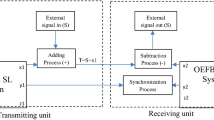Abstract
Chaotic systems provide a good mechanism for signal generation, with potential applications to communications. Because chaotic signals are difficult to predict, they can be used for bearing information signals in chaos-masking communication scheme. This paper describes communication with chaos. A message-bearing signal is hidden within the chaotic signal generated from the transmitter and recovered via chaos synchronization on the receiver side. Here in this paper, two analog computing circuits mimicking the characteristic of electro-optic modulator have been deployed as transmitter and receiver of the communication network. The whole setup has been realized in spice. The chaotic series obtained from the transmitter circuit was modulated and transmitted to the second one which behaves like a receptor and demodulates the chaotic signal through synchronization technique. The goal of this experiment was to design and simulate a simple chaos-masking communication scheme in SPICE using an electronic simulator for electro-optic modulator with a cos2 type of nonlinearity and subsequently realizing the noisy model of the whole setup using OpAmp-based electronic circuit. Simulation and analysis reveal the fact that the said simulator is highly insusceptible to noise, which is good for communication.








Similar content being viewed by others
References
Corron NJ, Hahs DW. A new approach to communications using chaotic signals. IEEE Trans Circuits Syst I Fundam Theory Appl. 1997;44(5):373–82. https://doi.org/10.1109/81.572333.
Pecora LM, Carroll TL. Synchronization of chaotic systems. Chaos. 1990;25(9):821–5. https://doi.org/10.1063/1.4917383.
Coumo KM, Oppenheim AV. Roubustness and signal recovery in a synchronized chaotic system. Int J Bifurc Chaos. 1993;3(6):1629–38.
Aihara K. Chaos and its applications. Proced IUTAM. 2012;5(1):199–203. https://doi.org/10.1016/j.piutam.2012.06.027.
Strogatz SH, Fox RF. Nonlinear dynamics and chaos: with applications to physics, biology, chemistry and engineering. New York: Perseus Book Publishing; 1995. p. 1–505. https://doi.org/10.1063/1.2807947.
Gastaud N, et al. Electro-optical chaos for multi-10 Gbit /s optical transmissions. Electron Lett. 2004;40(14):40–1.
Lavrov R, Peil M, Jacquot M, Larger L, Udaltsov V, Dudley J. Electro-optic delay oscillator with nonlocal nonlinearity: optical phase dynamics, chaos, and synchronization. Phys Rev E. 2009;80:1–9. https://doi.org/10.1103/PhysRevE.80.026207.
Ghosh AK, Verma P. The Lyapunov exponent of chaos generated by acousto-optic modulators with feedback. Opt Eng. 2011;50:1–20.
Palodiya V, Raghuwanshi SK. Performance Study of optical Modulator based on electrooptic effect. J Phys Conf Ser. 2016;735(1):1–8. https://doi.org/10.1088/1742-6596/735/1/012071.
Pisarchik AN, Ruiz-Oliveras FR. Optical chaotic communication using generalized and complete synchronization. IEEE J Quantum Electron. 2010;46(3):279–84. https://doi.org/10.1109/JQE.2009.2032429.
Gao JB, Hu J, Tung WW, Cao YH. Distinguishing chaos from noise by scale-dependent Lyapunov exponent. Phys Rev E. 2006;74(1–9):066204. https://doi.org/10.1103/PhysRevE.74.066204.
Ghosh AK, Dutta A, Mukherjee A. Noise tolerance in optical chaos encrypted communication using nonlinear electro-optic systems. In: Proceedings of Photonics International Conference on Fiber Optics and Photonics, IIT Delhi, 2018, pp. 1–2.
Larger L, Lacourt PA, Poinsot S, Hanna M. From flow to map in an experimental high-dimensional electro-optic nonlinear delay oscillator. Phys Rev Lett. 2005;95(4):043903. https://doi.org/10.1103/PhysRevLett.95.043903.
Ke J, et al. 32 Gb/s chaotic optical communications by deep-learning-based chaos synchronization. Opt Lett. 2019;44(23):5776–86. https://doi.org/10.1364/ol.44.005776.
Miliou AN, Antoniades IP, Stavrinides SG, Anagnostopoulos AN. Secure communication by chaotic synchronization: Robustness under noisy conditions. Nonlinear Anal Real World Appl. 2007;8(3):1003–12. https://doi.org/10.1016/j.nonrwa.2006.05.004.
Jiang X, et al. Electro-optic chaotic system based on the reverse-time chaos theory and a nonlinear hybrid feedback loop. Opt Express. 2016;24(25):28804–14. https://doi.org/10.1364/oe.24.028804.
Rosenstein MT, Collins JJ, De Luca CJ. A practical method for calculating largest Lyapunov exponents from small data sets. Phys D Nonlinear Phenom. 1993;65(1–2):117–34.
Kodba S, Perc M, Marhl M. Detecting chaos from a time series. Eur J Phys. 2005;26:205–15. https://doi.org/10.1088/0143-0807/26/1/021.
Balcerzak M, Pikunov D, Dabrowski A. The fastest, simplified method of Lyapunov exponents spectrum estimation for continuous-time dynamical systems. Nonlinear Dyn. 2018;94(4):3053–65. https://doi.org/10.1007/s11071-018-4544-z.
Ohtsubo J. Chaos synchronization and chaotic signal masking in semiconductor lasers with optical feedback. IEEE J Quantum Electron. 2002;38(9):1141–54. https://doi.org/10.1109/JQE.2002.801883.
Jakimoski G, Subbalakshmi KP. Discrete Lyapunov exponent and differential cryptanalysis. IEEE Trans Circiuts Syst. 2007;54(6):499–501.
Brandon J, Wiggins S. Introduction to applied nonlinear dynamical systems and chaos. Math Gaz. 1991;75(472):255.
Roy R. Optical communication with chaotic waveforms. Conf Proc Lasers Electro-Opt Soc Annu Meet. 1999;81(16):3547–50. https://doi.org/10.1109/leos.1999.813638.
Yi GH, He GW. Synchronous chaos in the coupled system of two logistic maps. Chaos Solitons Fractals. 2005;23(3):909–13. https://doi.org/10.1016/j.chaos.2004.04.036.
Lai YC, Ye N. Recent developments in chaotic time series analysis. Int J Bifurc Chaos. 2003;13(6):1383–422. https://doi.org/10.1142/S0218127403007308.
Author information
Authors and Affiliations
Corresponding author
Ethics declarations
Conflict of interest
No conflict of interest exists for all participating authors.
Additional information
Publisher's Note
Springer Nature remains neutral with regard to jurisdictional claims in published maps and institutional affiliations.
This article is part of the topical collection “Cyber Security and Privacy in Communication Networks” guest-edited by Rajiv Misra, R K Shyamsunder, Alexiei Dingli, Natalie Denk, Omer Rana, Alexander Pfeiffer, Ashok Patel and Nishtha Kesswani.
Rights and permissions
About this article
Cite this article
Datta, A., Mukherjee, A. & Ghosh, A.K. Simulation and Analysis of a Chaos-Masking Communication Scheme Based on Electronic Simulator for Electro-Optic Modulator with Noise. SN COMPUT. SCI. 2, 240 (2021). https://doi.org/10.1007/s42979-021-00622-8
Received:
Accepted:
Published:
DOI: https://doi.org/10.1007/s42979-021-00622-8




